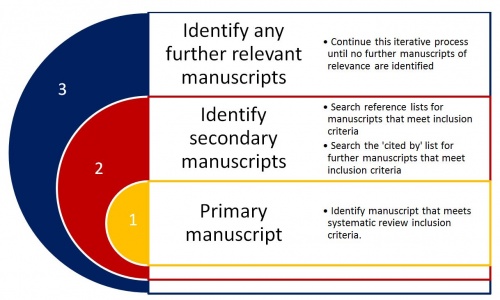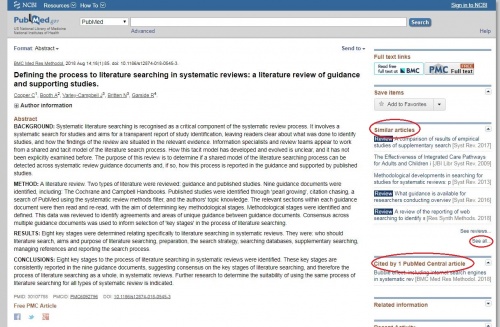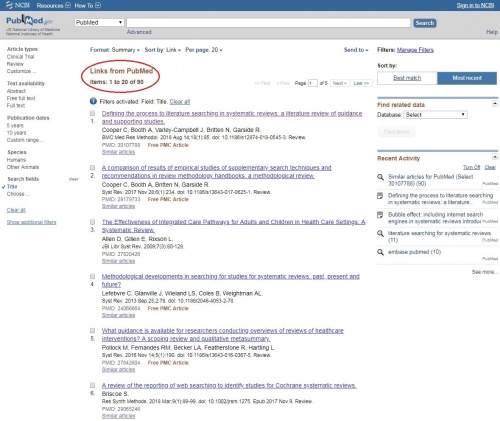‘Pearl growing’ (also known as ‘Citation mining’ or ‘Snowballing’) is an effective approach to systematic literature searching which helps to ensure that all relevant literature has been identified.
All three names hint at the iterative process involved – a grain of sand in an oyster grows slowly, layer by layer, into a pearl – one citation is mined, by digging deeper into the reference list and then digging even deeper into the references cited by those references – or a snowball is grown into a larger snowball by adding more layers of snow (Figure 1).
Figure 1 below illustrates the process involved in ‘pearl growing’. In step one, an article that meets the systematic review inclusion criteria is identified. In step two new relevant articles are identified by checking reference lists. This process is done be searching both ‘backwards’ i.e., the papers cited by the article of interest and ‘forwards’ i.e., any papers that have cited the article of interest. This iterative process is continued until no further relevant articles are identified.

In practice, these steps can be facilitated by using an online database such as PubMed. When a primary relevant manuscript is identified (Figure 2) the references cited by this paper are listed in the ‘Similar articles’ section. By clicking on this section a list will open that contains the full bibliography and all cited articles (Figure 3). This list can be systematically searched for further relevant articles. Any articles that have cited the primary relevant manuscript can also be identified by clicking on the ‘Cited by xx PubMed Central articles’ button (Figure 2).


It has been reported that up to 51% of references in a systematic review are identified by pearl growing. (1) Yet, although experienced researchers regularly use the pearl growing technique when conducting a systematic review, it is rarely reported in the methods section.(2)

Studies have shown that using the pearl growing technique is more comprehensive than database searching in identifying all the relevant manuscripts.(3) There is emerging evidence that identifying ‘golden bullets’, which is the term for those articles that should unquestionably be included in your systematic review, is a novel starting point for a systematic review.(4) Future developments in AI and machine-based learning are likely to automate this process. It will soon be possible to input key papers and criteria and identify all relevant manuscripts in one simple step.(5)
In the meantime, pearl growing using PubMed Central is a useful technique for ensuring your systematic review includes all relevant literature. Just don’t forget to mention that you used this technique in your Methods section!

References
(1) Greenhalgh T, Peacock R. Effectiveness and efficiency of search methods in systematic reviews of complex evidence: audit of primary sources. BMJ. 2005 Nov 5;331(7524):1064-5. Epub 2005 Oct 17. Review.
(2) Vassar M, Atakpo P, Kash MJ. Manual search approaches used by systematic reviewers in dermatology. J Med Libr Assoc. 2016 Oct;104(4):302-304. PubMed PMID: 27822152; PubMed Central PMCID: PMC5079492.
(3) Badampudi, Deepika & Wohlin, Claes & Petersen, Kai. (2015). Experiences from using snowballing and database searches in systematic literature studies. 1-10. 10.1145/2745802.2745818.
(4) Zwakman M, Verberne LM, Kars MC, Hooft L, van Delden JJM, Spijker R. Introducing PALETTE: an iterative method for conducting a literature search for a review in palliative care. BMC Palliat Care. 2018 Jun 2;17(1):82. doi: 10.1186/s12904-018-0335-z.
(5) Extance, A. How AI technology can tame the scientific literature. Nature 561, 273-274 (2018) doi: 10.1038/d41586-018-06617-5
